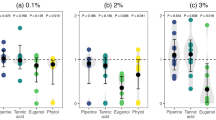Abstract
We investigated the attractiveness of grapefruit oil to the Mexican fruit fly. Only high concentrations were attractive in laboratory wind-tunnel bioassays. Attraction of flies to grapefruit oil was not enhanced if they had previous experience with grapefruit. In citrus orchard experiments, undiluted grapefruit oil attracted Mexican fruit flies and enhanced attraction to traps baited with a synthetic food-odor lure emitting ammonia and other nitrogenous chemicals. This is the first demonstration of host fruit odor increasing attraction to another type of attractive blend in Mexican fruit fly. These results indicate differences in the way the flies respond to undiluted grapefruit oil compared with previously tested fruit odors.

Similar content being viewed by others
References
Abacus Concepts. 1989. SuperANOVA. Abacus Concepts, Inc., Berkeley, CA.
M. L. Cornelius L. Nergel J. J. Duan R. H. Messing (2000) ArticleTitleResponses of female oriental fruit flies (Diptera: Tephritidae) to protein and host fruit odors in field cage and open field tests Environ. Entomol. 29 14–19
R. T. Cunningham (1989) Parapheromones A. S. Robinson G. Hooper (Eds) Fruit Flies, their Biology, Natural Enemies and Control, Vol. 3A Elsevier New York 221–230
J. C. Dickens E. B. Jang D. M. Light A. R. Alford (1990) ArticleTitleEnhancement of insect pheromone responses by green leaf volatiles Naturwissenschaften 77 29–31
B. S. Fletcher R. J. Prokopy (1991) Host location and oviposition in tephritid fruit flies W. J. Bailey J. Ridsdill-Smith (Eds) Reproductive Behaviour of Insects: Individuals and Populations Chapman and Hall New York 139–171
F. M. Howlett (1915) ArticleTitleChemical reactions of fruit flies Bull. Entomol. Res. 6 297–305
E. B. Jang D. M. Light (1996) Olfactory semiochemicals of tephritids B. A. McPheron G. J. Steck (Eds) Fruit Fly Pests: A World Assessment of their Biology and Management St. Lucie Press Delray Beach, FL 73–90
P. J. Landolt T. W. Phillips (1997) ArticleTitleHost plant influences on sex pheromone behavior of phytophagous insects Annu. Rev. Entomol. 42 371–391
P. J. Landolt H. C. Reed R. R. Heath (1992) ArticleTitleAttraction of female papaya fruit fly (Diptera: Tephritidae) to male pheromone and host fruit Environ. Entomol. 21 1154–1159
G. B. Maccollom C. R. Lauzon E. B. Payne W. W. Currier (1994) ArticleTitleApple maggot (Diptera: Tephritidae) trap enhancement with washed bacterial cells Environ. Entomol. 23 354–359
D. C. Robacker (1991) ArticleTitleSpecific hunger in Anastrepha ludens (Diptera: Tephritidae): Effects on attractiveness of proteinaceous and fruit-derived lures Environ. Entomol. 20 1680–1686
D. C. Robacker I. Fraser (2003) ArticleTitleRelative attractiveness of oranges and grapefruits to Mexican fruit flies (Diptera: Tephritidae) in a wind tunnel J. Entomol. Sci. 38 566–575
Robacker, D. C. and Fraser, I. 2005. What do Mexican fruit flies learn when they experience fruit? J. Insect Behav 18(4).
D. C. Robacker J. A. Garcia (1990) ArticleTitleResponses of laboratory-strain Mexican fruit flies, Anastrepha ludens, to combinations of fermenting fruit odor and male-produced pheromone in laboratory bioassays J. Chem. Ecol. 16 2027–2038
D. C. Robacker R. R. Heath (1996) ArticleTitleAttraction of Mexican fruit flies (Diptera: Tephritidae) to lures emitting host-fruit volatiles in a citrus orchard Fla. Entomol. 79 600–602
D. C. Robacker R. R. Heath (1997) ArticleTitleDecreased attraction of Anastrepha ludens to combinations of two types of synthetic lures in a citrus orchard J. Chem. Ecol. 23 1253–1262
D. C. Robacker W. C. Warfield (1993) ArticleTitleAttraction of both sexes of Mexican fruit fly, Anastrepha ludens, to a mixture of ammonia, methylamine, and putrescine J. Chem. Ecol. 19 2999–3016
D. C. Robacker J. A. Garcia W. G. Hart (1990) ArticleTitleAttraction of a laboratory strain of Anastrepha ludens (Diptera: Tephritidae) to the odor of fermented chapote fruit and to pheromones in laboratory experiments Environ. Entomol. 19 403–408
D. C. Robacker A. M. Tarshis Moreno J. A. Garcia R. A. Flath (1990) ArticleTitleA novel attractant for Mexican fruit fly, Anastrepha ludens, from fermented host fruit J. Chem. Ecol. 16 2799–2815
T. E. Shelly A. M. Dewire (1994) ArticleTitleChemically mediated mating success in male Oriental fruit flies (Diptera: Tephritidae) Ann. Entomol. Soc. Am. 87 375–382
G. W. Snedecor W. G. Cochran (1967) Statistical Methods The Iowa State University Press Ames
K. H. Tan R. Nishida (1996) Sex pheromone and mating competition after methyl eugenol consumption in Bactrocera dorsalis complex B. A. McPheron G. J. Steck (Eds) Fruit Fly Pests: A World Assessment of their Biology and Management St. Lucie Press Delray Beach, FL 147–153
K. H. Tan R. Nishida (1998) ArticleTitleEcological significance of a male attractant in the defence and mating strategies of the fruit fly pest, Bactrocera papayae Entomol. Exp. Appl. 89 155–158
Acknowledgments
We thank Maura Rodriguez (USDA ARS, Weslaco, TX) for technical assistance. Use of a product brand in this work does not constitute an endorsement by the USDA.
Author information
Authors and Affiliations
Corresponding author
Rights and permissions
About this article
Cite this article
Robacker, D.C., Rios, C. Grapefruit Oil Enhances Attraction of Mexican Fruit Flies to a Synthetic Food-Odor Lure. J Chem Ecol 31, 1039–1049 (2005). https://doi.org/10.1007/s10886-005-4246-0
Received:
Accepted:
Published:
Issue Date:
DOI: https://doi.org/10.1007/s10886-005-4246-0




